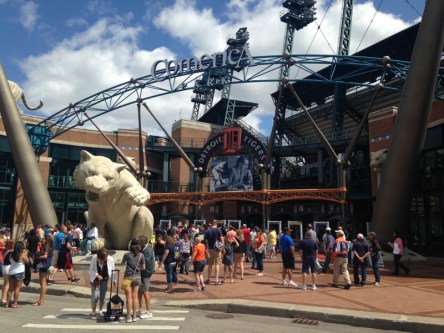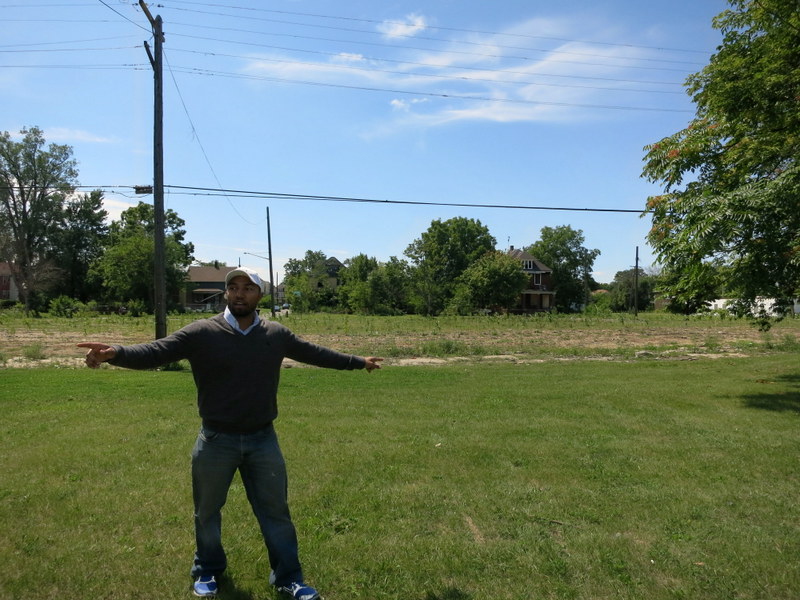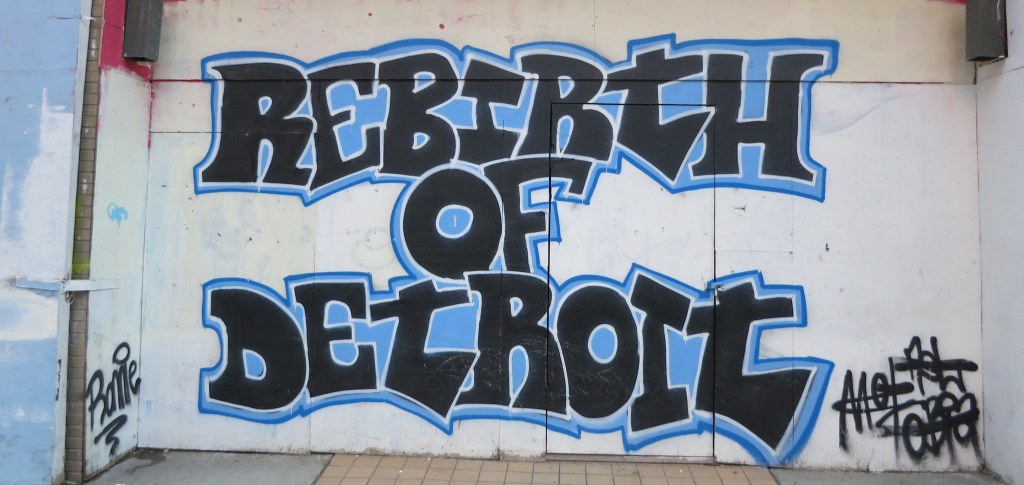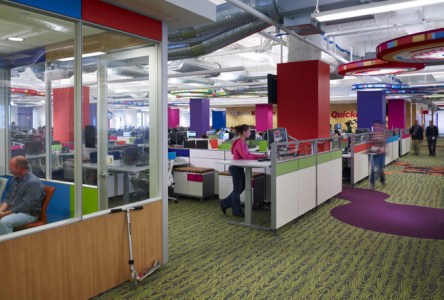Ed. note: The third in a three-part series, our final article on the real estate realities for Detroit, Michigan, as the city emerges from a long period of decline. Read the first installments here (Part 1) and here (Part 2). Walking around downtown Detroit, at many times of day, feels like one has wandered onto a deserted movie set. Historic skyscrapers loom overhead. There are hints of change and progress: work on a new rail line, construction fences around old buildings, for rent signs in windows. What you don’t see, that feels strangest of all, are very many people. At 8 a.m. and 5 p.m., there is foot traffic as employees walk to or from their jobs. A great many of them are wearing Quicken Loan employee ID badges, identifying them as part of Dan Gilbert’s empire. Gilbert’s investment in the city, from real estate purchases – more than 50 buildings to date – in addition to centering Quicken’s headquarters downtown and funding a large portion of the M:1 RAIL line, is ubiquitous. “Dan Gilbert obviously is leading the charge in downtown real estate reinvestment. He’s acquired 52 properties in the last couple of years, for Quicken and various subsidiary companies of his own,” said John Latessa, Senior Managing Director of CBRE’s Michigan operations. The other major property accumulator, the Caesars Pizza-founding, sports team-owning Ilitch family, has been buying up lots and decaying buildings for a new hockey stadium for years. “(Gilbert and the Ilitches) are generating the interest that didn’t exist before. If they weren’t doing this stuff and couldn’t do it on their own, a lot of these other projects wouldn’t be possible,” said Scott Allen, president of Fourmidable, a Detroit-based multifamily property management firm. Rising rents for multifamily Detroit’s real estate...
On the Urban Prairie
New uses for open space
Drive out of Detroit’s Downtown and Midtown neighborhoods, away from the historic skyscrapers and abandoned ruins of once-grand buildings, and you are quickly amidst a whole different kind of surreal scene. Once densely packed with people, Detroit’s outlying single family home neighborhoods have suffered immensely from the city’s ongoing depopulation. Across the city’s 149 square miles, nearly every neighborhood had 15 percent of its homes abandoned or foreclosed. There are still an estimated 80,000 structures left standing. This summer, the federal government pushed Detroit to spend $850 million to tear down 40,000 of them in the long slogging war against blight. Adam Hollier, Detroit native, Cornell graduate, and former City Council liaison for the Detroit Mayor’s office, sees the city’s sparsely peopled suburbs as an opportunity for change, and a new way of looking at urban life – one with plenty of open space. Hollier’s new job isn’t in politics or real estate, but on Detroit’s vast urban prairie. Working for Hantz Farms, he leads a small team that planted 15,000 trees this summer in one of Detroit’s declining western neighborhoods. Hantz Farms purchased 1700 parcels, totaling 150 acres, from the city to create their “Woodlands,” where the grass and trash that covers houseless lots has been cleared. John Hantz, CEO and owner of Hantz Farms, lives in Indian Village, a historic neighborhood just a few streets away. “What we’re doing clears the way so that other people can invest in the neighborhood. The goal is that that will bring other investment in housing or commercial real estate. It’s very similar to what Dan Gilbert is doing downtown, in that you know you’re throwing good money after good money,” Hollier explained. The results of the clearing are impressive. From a lot that hasn’t yet been worked over, overgrown bushes spilled onto what would have once been a neighborhood street. Trash is everywhere – old tires, pieces of burnt wood, broken glass bottles. Five houses might now sit on a street where there were once 25, shoehorned into tiny 30’’ by 60’’ lots. It’s on the blocks where the debris has been cleared that the urban prairie really looks like a prairie. “Now you can see four, five, six blocks in any direction,” Hollier pointed out “And if you don’t talk for two seconds it sounds like you’re in the country. Which is a really weird thing when you’re four miles from downtown.” Over the next two summers, the Hantz team plans to plant an additional 30,000 trees. Some parcels may be used for farming – two ventures, growing mushrooms and hops – are in the planning stages. Produce and jobs Hantz Farms isn’t the only company working on new life for the urban prairie. Gary Wozniack is a man with a dream of repurposing 310 acres of vacant, city-owned land for high-yield agriculture, and simultaneously creating up to 700 jobs, most paying $10 an hour. It’s a 20 year plan that will begin in to ramp up with the first 25 acres over the next year. The work would be suitable for employees with limited education and professional skills, including those who have done prison time or struggled with addiction, a type of opportunity that is sorely needed but rarely available in Detroit. “We have a huge untrained labor force, probably upwards of 200,000 adults in the city,” said Wozniack, a native Detroiter and RecoveryParks President/CEO. This summer, the unemployment rate has hovered above 14 percent. This fall, RecoveryPark expects to finalize its initial land deal with the city, purchasing the farm’s first 25 for just $1. The purchase will include the crumbling historic Chene-Ferry Market, an open air structure covered with trash that will become a headquarters for the operation. The neighborhood where RecoveryPark will grow is even harder hit by abandonment than Hantz’ Woodlands blocks. It’s located on the city’s near east side, not far from the...
Divining Detroit
Motor City's Second Act
The first thing you learn in Detroit is that you don’t know anything about Detroit. Most Americans – even many Michigan residents – perceive the city as crime-ridden, crumbling, conundrum. Spend a day or two in Detroit and you’ll likely come away with a different impression: one of a place that, as one lifelong resident put it, “has gone through hell, and now, very quietly, there are pockets of rebirth.” Rebirth, encore, renaissance – these are the kinds of words you hear a lot of when talking to passionate Detroiters. Their enthusiasm is infectious. The city’s transformation from a metropolis of 2 million to a city of 688,700 (and falling) – and what comes next – is a story that fascinates. Comebacks, after all, are one of America’s favorite plotlines. The real estate broker Austin Black II has a problem, one that most residential real estate agents or brokers in America would envy: he needs more condos and lofts to sell, because buyers are beating down his door. From 2013 to 2014, Black’s business at City Living Detroit, a full service residential brokerage specializing in the greater Downtown and Midtown neighborhoods, has jumped more than 25 percent. “It would be higher if there was more inventory. The average sale price is up substantially over last year,” Black notes. In fact, the prices for the units he has sold – starting at $200,000 and going up to $600,000 – are virtually unheard of in still-struggling Detroit’s single family home market. The reasons are attributable to the two oldest themes of real estate: supply and demand, and location, location, location. Since the 2008-2010 economic slump, just one new for-sale condo project has come online in the coveted Midtown area, home to Wayne State University and Detroit Medical Center. Other housing projects under construction are rentals, and while rents are on the upswing, Black says his clients would prefer to buy. “Pre-recession, most buyers were all young professionals, either right out of college or not too far out. That market has changed drastically to include young professionals, mid-career professionals, established executives and empty nesters. It’s a very diverse market now, more typical of what you see in other major cities,” Black says. He’s even seeing many locals moving back toward the city from the suburbs, lured by a low-maintenance multifamily lifestyle. There are incentives to urban living for buyers and renters alike. Nine major Detroit employers participate in a program that provides a $20,000 forgivable down payment loan for a home purchase near the commercial core, or a rental subsidy paid directly to the landlord. Adding to the future appeal of the neighborhoods Black sells is the ongoing construction of the M-1 RAIL, a 3.3 mile long circulating streetcar along Woodward Avenue that will begin to link the downtown core with the outlying suburbs. Considering the vast expanse of territory that makes up Detroit – the city is 149 square miles in size – it’s just a start to fixing a chronic transit problem. If you live or work in Detroit, locals say, a car or bike is the only way to efficiently get from place to place right now. The evangelist Jeanette Pierce grew up in Detroit and spent most of her 20’s living in the heart of downtown. She loved the lifestyle so much that she turned her passion into a full time job: reputation management and education about what’s really doing on in D-town. Today, she and her husband, a scientist, are homeowners in Lafayette Park, a downtown adjacent neighborhood that’s just a few blocks from the businesses, casinos, stadiums and hotels in the downtown core. Jeanette calls Detroit “MY city” with the ferocity of a mother bear protecting her cub. She started her tours to show fellow locals that “we’re not martyrs” for choosing life outside of suburbia. Her business is now part of a foundation-funded non-profit, D:Hive,...
Bedrock Real Estate
Leading resurgence in Detroit
Detroit refuses to settle for the status of a has-been city. Tough economic times have certainly taken a toll. But rather than losing hope, city leaders are seizing the opportunity to recreate The Motor City as a metropolitan hub valued for its cultural offerings. Yardi client Bedrock is leading the way in the resurgence of one of America’s most iconic cities. Dan Mullen, Vice President of Development at Bedrock, has never doubted that Detroit was worth the fight. “It’s an amazing opportunity to be in Detroit,” he says. “An urban location provides this indescribable energy: being surrounded by industry, historic architecture, a place where everything is walkable, where you can work and play. As a company, having the opportunity to purchase and redevelop historic buildings and impact the outcome of one of the great American cities is something that we take pride in.” Bedrock leverages its position as the real estate services branch of Quicken Loans to purchase and redevelop properties in the downtown district. Bedrock works with affiliate companies to then “tie the thread,” or work together in the redevelopment process to ensure that local companies reap the benefits of the city’s growth. It’s truly a team effort that aims to pull everyone forward together. Mullen values the collaborative process, “We work closely with the city, Detroit Economic Growth Corporation, other developers and local businesses. We’re all one big team to help revitalize all of downtown Detroit. Bedrock definitely plays a role in [the resurgence] but we also have a lot of amazing partners.” The partnerships have helped Bedrock develop 8 million square feet of commercial space. But that’s only the tip of the iceberg. Demand for quality office space is rising downtown. Bedrock has responded by purchasing historic buildings, giving them a...




